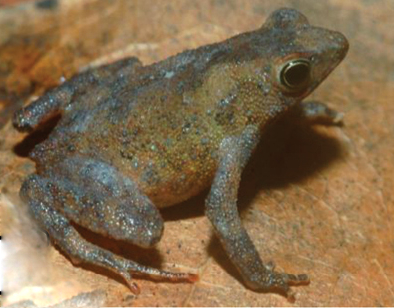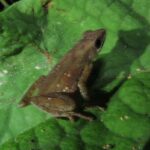- Introduction: The Hidden Jewel of the Amazon
- Taxonomy and Classification: Unveiling an Amazonian Specialist
- Natural Habitat: Secrets of the Forest Floor
- Physical Characteristics: Tiny and Remarkably Adapted
- Behavior and Life Cycle: Secrets Beneath the Leaf Litter
- Ecological Role: Guardians of Balance
- Threats and Conservation Status: Fragility Amidst Change
- Cultural and Scientific Significance: Reflecting Amazon’s Richness
- Conclusion: Championing Conservation for an Amazonian Marvel
Introduction: The Hidden Jewel of the Amazon#
Deep in the lush, verdant undergrowth of Brazil’s Amazon rainforest, a small amphibian with a big story quietly persists, well-hidden and almost unknown to the outside world. Meet Amazophrynella bokermanni, commonly extending no larger than a thumbnail, yet embodying profound biological significance. First described scientifically as recently as 1994, this species illustrates just how much remains unexplored within the colossal tapestry of Amazonian biodiversity.
Though it may measure barely 20 millimeters in length, its existence carries a distinctive narrative entwined with pristine rainforest ecosystems, enigmatic evolutionary adaptations, and the pressing importance of conservation. In this article, journey with me into the secretive life of Amazophrynella bokermanni, unraveling insights into its habitat, characteristics, behaviors, ecological roles, and the conservation challenges it faces today.
Taxonomy and Classification: Unveiling an Amazonian Specialist#
Belonging to the family Bufonidae—a diverse group known for their terrestrial lifestyles and parotid glands secreting various toxins—the species Amazophrynella bokermanni is firmly rooted in a unique lineage tailored specifically for life beneath dense rainforest canopies. Within the genus Amazophrynella, it coexists with closely related cousins like Amazophrynella minuta and Amazophrynella vote, all equally intriguing examples of evolution’s fine-tuning.
The frog’s specific epithet, ‘bokermanni,’ honors revered Brazilian herpetologist Werner C. A. Bokermann. Celebrated for his extensive contributions to amphibian research in Brazil, his legacy continues to inspire studies and conservation efforts among herpetological communities worldwide.
Natural Habitat: Secrets of the Forest Floor#
Amazophrynella bokermanni inhabits specific microhabitats within Brazil’s central Amazon basin, primarily in regions characterized by dense primary rainforest, humid leaf litter, and proximity to gentle freshwater streams. Most observations and research indicate that this frog favors low-lying, undisturbed areas within pristine forest ecosystems, typically near slow-flowing creeks and ponds that support reproduction and development.
Beneath towering trees such as copaiba, guariuba, and rubber trees, an intricately woven carpet of decomposing leaves and organic matter conceals this tiny creature’s daily existence. Humidity hovers above 80 percent for most of the year, crafting a stable microclimate crucial for skin respiration and optimal physiological function. Amidst these softly humid microhabitats, this unassuming amphibian lives relatively undisturbed, blending seamlessly with its surroundings.
The complexity of this habitat is astounding; vibrant fungi colonize decaying wood, delicate orchids hang precariously from shaded branches, and hidden creatures—ranging from leaf-cutting ants to elusive, colorful bird species—interact daily, shaping a delicate ecological balance upon which frogs like Amazophrynella bokermanni depend.
Physical Characteristics: Tiny and Remarkably Adapted#
The diminutive size of Amazophrynella bokermanni renders it immediately captivating. Typically not exceeding 2 centimeters in length, it ranks among one of the rainforest’s truly miniature vertebrates. Its coloration ranges from soft hues of brown to rich earth shades, often dappled with subtle patterns that mimic fallen leaves and twigs—an evolutionary masterstroke enabling remarkable camouflage.
Its skin texture, adorned with small tubercles and slight granular ridges, contributes not only to camouflage but also to enhancing moisture retention, a vital adaptation for life in humid yet rapidly changing rainforest conditions. The characteristic enlarged parotid glands, although small and understated compared to those in more toxic relatives, still function effectively, secreting chemical compounds that deter small predators and parasites.
The eyes are proportionately large relative to the head, their lustrous bronze-gold coloration enhanced by dark horizontal pupils adapted superbly to dim, dappled forest habitats, fine-tuned evolutionarily to detect prey items and predators amid minimal illumination.
Behavior and Life Cycle: Secrets Beneath the Leaf Litter#
Much of what we know about Amazophrynella bokermanni‘s behavior comes from carefully conducted field studies and patient observation by dedicated herpetologists. Primarily diurnal, these frogs display peak activity during the cooler, moist hours of early morning and late afternoon, minimizing water loss and thermal stress during midday temperatures.
Feeding Behavior: Small yet Efficient Hunters#
Even at its minimal size, Amazophrynella bokermanni actively hunts small invertebrates that crawl silently among fallen leaves and damp earth. It preys predominantly on tiny ants, mites, springtails, and small beetles—each abundant within its microhabitat. With a quick flick of their sticky tongues, precise and refined through millennia of evolution, these minute predators demonstrate astounding effectiveness in securing nourishment.
Mating and Breeding: Harmonies of the Forest Floor#
During the onset of rainy seasons, males take up strategic positions near shallow pools formed by rainfall or seasonal rivulets. Their soft, insect-like calls—described by researchers as a delicate, rhythmic chirping—offer melodious accompaniment to the Amazon’s orchestration of sounds. Females, attracted toward these gentle harmonies, select mates displaying the finest vocal finesse.
After pairing, females deposit small clusters of gelatinous eggs amid inundated leaf litter or shallow ponds. The emerging tadpoles quickly adapt to temporary aquatic conditions, metamorphosing swiftly into miniature replicas of their parents. This rapid developmental process reduces vulnerability periods in temporary aquatic environments leveraged by various predators.
Ecological Role: Guardians of Balance#
As predators of minute invertebrates, Amazophrynella bokermanni play a significant role in controlling local populations of soil arthropods. By consuming insects that could otherwise dominate local ecosystems, their presence reflects—and helps sustain—the intricate balance in the microcosm of the forest understory.
Concurrently, they form part of the food chain, being prey to various predatory invertebrates, larger amphibian species, small reptiles, and forest-dwelling birds. This dual ecological function exemplifies the vital interactions existing within Amazonian ecosystems, contributing intricately to overall community health and biodiversity resilience.
Threats and Conservation Status: Fragility Amidst Change#
Currently classified as “Data Deficient” by the International Union for Conservation of Nature (IUCN), the true population size and trends of Amazophrynella bokermanni remain largely unknown. Nonetheless, accelerated habitat destruction, driven predominantly by deforestation for agriculture, logging, and infrastructure expansion, poses significant existential threats.
Climate change inflicts additional pressures on its delicate rainforest habitat, altering rainfall patterns, temperature regimes, and potentially disrupting breeding cycles. Disease outbreaks—such as chytridiomycosis, devastating amphibian populations worldwide—further amplify concern. Conservation scientists highlight this species as potentially vulnerable, necessitating proactive habitat protection, population research, and monitoring initiatives.
Cultural and Scientific Significance: Reflecting Amazon’s Richness#
While the scientific community deeply respects Amazophrynella bokermanni for its evolutionary adaptations and ecological importance, the species also symbolizes the immense biodiversity the Amazon hosts. It serves as an indicator species, reflecting ecosystem health—its very presence signals environmental integrity. The novelty of its discoverability and the ongoing revelations surrounding its biology encourage new generations of researchers and conservationists toward deeper respect, curiosity, and stewardship for nature’s complexity.
Conclusion: Championing Conservation for an Amazonian Marvel#
Though often hidden in plain sight, small species like Amazophrynella bokermanni persist as profound reminders of our planet’s spectacular biodiversity. Their diminutive forms conceal remarkable adaptations and ecological importance, spotlighting the intricate interconnectedness of all living beings.
As nature enthusiasts, students, and conservationists, we must advocate strongly for research, education, and habitat conservation efforts supporting these frogs and their ecosystems. Let the fragile existence of this minute amphibian motivate collective action aimed at safeguarding the unparalleled biodiversity treasures of the Amazon for generations to come.









